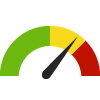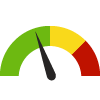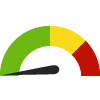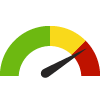Advanced Search: Build a Custom Dashboard
In the fields below, search for indicators by location, topics, population, classification, subgroup, or comparison. No fields are required, but we suggest selecting a location or two to start. In the additional search options section, select options to group and order search results. To learn more about how to customize a dashboard, see our help center.
Visit the Indicator List Page to see the full list of indicators and locations available on the site.
Search Results:
Indicator Gauge Icon Legend
Legend Colors
Red is bad, green is good, blue is not statistically different/neutral.
Compared to Distribution
 the value is in the best half of communities.
the value is in the best half of communities.
 the value is in the 2nd worst quarter of communities.
the value is in the 2nd worst quarter of communities.
 the value is in the worst quarter of communities.
the value is in the worst quarter of communities.
Compared to Target
 meets target;
meets target;  does not meet target.
does not meet target.
Compared to a Single Value
 lower than the comparison value;
lower than the comparison value;
 higher than the comparison value;
higher than the comparison value;
 not statistically different from comparison value.
not statistically different from comparison value.
Trend

 non-significant change over time;
non-significant change over time; 
 significant change over time;
significant change over time;  no change over time.
no change over time.
Compared to Prior Value
 higher than the previous measurement period;
higher than the previous measurement period;
 lower than the previous measurement period;
lower than the previous measurement period;
 no statistically different change from previous measurement period.
no statistically different change from previous measurement period.
Health / Older Adults
Health / Older Adults
State: Kansas
State: Kansas Adult Day Care Spending-to-Income Ratio
State: Kansas Adult Day Care Spending-to-Income Ratio



State: Kansas Adults 65+ with a Disability
State: Kansas Adults 65+ with a Disability


State: Kansas Adults 65+ with a Hearing Difficulty
State: Kansas Adults 65+ with a Hearing Difficulty


State: Kansas Adults 65+ with a Self-Care Difficulty
State: Kansas Adults 65+ with a Self-Care Difficulty


State: Kansas Adults 65+ with a Vision Difficulty
State: Kansas Adults 65+ with a Vision Difficulty


State: Kansas Adults 65+ with an Independent Living Difficulty
State: Kansas Adults 65+ with an Independent Living Difficulty





State: Kansas Age-Adjusted Years of Potential Life Lost - Alzheimers
State: Kansas Age-Adjusted Years of Potential Life Lost - Alzheimers


State: Kansas Alzheimer's Disease or Dementia: Medicare Population
State: Kansas Alzheimer's Disease or Dementia: Medicare Population




State: Kansas Asthma: Medicare Population
State: Kansas Asthma: Medicare Population




State: Kansas Atrial Fibrillation: Medicare Population
State: Kansas Atrial Fibrillation: Medicare Population




State: Kansas Cancer: Medicare Population
State: Kansas Cancer: Medicare Population




State: Kansas Chronic Kidney Disease: Medicare Population
State: Kansas Chronic Kidney Disease: Medicare Population




State: Kansas COPD: Medicare Population
State: Kansas COPD: Medicare Population




State: Kansas Depression: Medicare Population
State: Kansas Depression: Medicare Population




State: Kansas Diabetes: Medicare Population
State: Kansas Diabetes: Medicare Population




State: Kansas Heart Failure: Medicare Population
State: Kansas Heart Failure: Medicare Population




State: Kansas Hyperlipidemia: Medicare Population
State: Kansas Hyperlipidemia: Medicare Population




State: Kansas Hypertension: Medicare Population
State: Kansas Hypertension: Medicare Population




State: Kansas Ischemic Heart Disease: Medicare Population
State: Kansas Ischemic Heart Disease: Medicare Population




State: Kansas Mammography Screening: Medicare Population
State: Kansas Mammography Screening: Medicare Population




State: Kansas Osteoporosis: Medicare Population
State: Kansas Osteoporosis: Medicare Population




State: Kansas People 65+ Living Alone
State: Kansas People 65+ Living Alone



State: Kansas People 65+ Living Alone (Count)
State: Kansas People 65+ Living Alone (Count)

State: Kansas People 65+ Living Below Poverty Level
State: Kansas People 65+ Living Below Poverty Level



State: Kansas People 65+ Living Below Poverty Level (Count)
State: Kansas People 65+ Living Below Poverty Level (Count)





State: Kansas Stroke: Medicare Population
State: Kansas Stroke: Medicare Population





